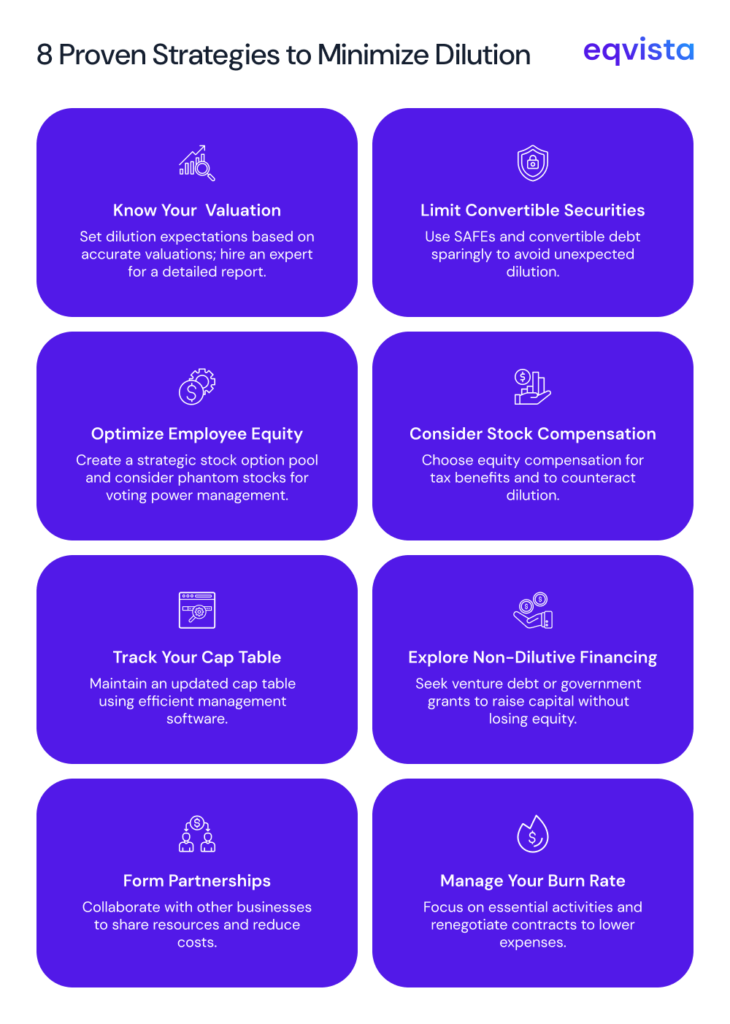How Can I Ensure My Startup Growth Without Giving Up Too Much Equity?
As a startup founder, you will often find yourself weighing the opportunity to scale your business against the cost of dilution. Dilution is not only undesirable from a purely financial standpoint but it also risks your control over the company. Hence, it is crucial to understand how much dilution is acceptable and how you can grow sustainably without sacrificing too much equity.
Typically, startup founders experience 10-20% dilution in the seed round and 20-25% dilution in the Series A round. In later funding rounds, if your startup is already generating a positive net cash flow and has low dependence on external funding, you can get away with low equity dilution. However, in crises, you may need to make your peace with dilution of in excess of 50%.
In this article, we have compiled actionable insights to help you navigate funding rounds with confidence, manage dilution, and continue growing your business without compromising on its future. Read on to learn more!

8 Effective Strategies to Minimize Dilution
Minimizing dilution is crucial for startups as it helps maintain ownership stakes and control over the company. Here are some strategies to help drive your startup’s growth while minimizing equity dilution:
Know your valuation
Many founders who are not issuing equity compensation make the mistake of setting valuation expectations based on their funding requirements when they should be setting dilution expectations based on their valuations. As a result, such founders are already at a disadvantage even before reaching the negotiation table.
Such mistakes are less common with founders who issue equity compensation since that requires regular business valuations to establish the income and tax liabilities of employees receiving equity compensation.
So, before you head into a funding round, hire an independent valuation service provider like Eqvista and get a detailed report explaining your startup’s valuation. Such a report will show your startup’s progress toward its goals and present well-informed and compelling arguments during fundraising negotiations.
Limit the usage of convertible securities
To accommodate various kinds of investors, startups issue numerous convertible securities such as Simple Agreements for Future Equity (SAFEs), convertible debt, and warrants. Since these securities do not have any immediate dilution effect, many founders believe that they can repurchase and cancel such convertible securities.
However, things may not always unfold as planned. Therefore, you should limit the issuance of convertible securities to an amount you are comfortable being exercised in the near future.
Optimize your employee equity compensation plan
Most startups issue equity compensation to attract and retain talent while preserving their cash reserves. While this is a necessary employee compensation practice, you must be careful not to overdo it. Instead of issuing equity compensation in an unplanned manner, you should aim for thoughtful equity allocation that ensures sustainable growth. You can do so by creating an employee stock option pool that reflects your hiring plans and the level of dilution from equity compensation that is acceptable to you.
Managing the dilution of voting power is also an important aspect of startup equity management which can be achieved by issuing phantom stocks. These are assets that will be tied to your company’s stock and provide the benefits of capital gains and dividends but do not carry any voting power.
Since phantom stocks can have clauses for company-only redemption or non-transferability, you need not worry about any third-party purchasing equity from your employees to have more power over your company’s board.

Consider receiving stock compensation
At most publicly traded companies, top executives receive only 10% of their salary as cash. Similar trends are being observed in pre-IPO companies as well. The rest of their salary is paid as equity compensation for two reasons.
Firstly, most top executives are subject to the 37% individual income tax but pay a significantly lower long-term capital gains tax rate of up to 20%. Thus, paying long-term capital gains tax on equity compensation instead of paying income tax on cash compensation unlocks tax savings.
Secondly, receiving equity compensation allows you to counter dilution experienced from funding rounds and employee stock options. Investors typically negotiate performance-based conditions for granting equity compensation to founders which is a fair ask from their standpoint as it aligns the founders’ incentives with the company’s long-term success.
Track your cap table
You should maintain a cap table that summarizes your company’s ownership structure. This table should list the names of all stakeholders and any active option pools. You can also add columns for investment amount, current value of stake, ownership percentage, type of equity interest held, and links to documents explaining the special rights afforded by preferred shareholders and others who hold convertible securities.
You must update your cap table whenever you issue any form of equity, add new shareholders, or remove shareholders as well as when stock options get vested and exercised. Regular updates are crucial for effective startup equity management as they help you understand the equity dilution level at any given point in time.
Since creating and managing a cap table is a time-intensive task, you can rely on cap table management software such as Eqvista. In addition to simplifying the issuance of equity and tracking ownership structures, we also offer features such as scenario modeling that make it easier to understand the potential dilution from a proposed funding round.
Consider non-dilutive financing options
Startup fundraising is not limited to just equity funding. You should also explore avenues such as venture debt which is a form of bridge financing offered to venture-backed startups. Typically, venture debt allows you to raise about 20% to 40% of the amount raised in the previous funding round.
If your startup is involved in highly innovative research and development (R&D), it may qualify for various grants issued by government bodies such as the National Science Foundation (NSF), and the Department of Energy (DOE). You can also receive 7(a) loans of up to $5 million from the Small Business Administration (SBA) if you meet their requirements.
Explore growth through partnerships
Most startup founders realize that they need to have lean operations and focus on product development and finding evidence for product-market fit. In this endeavor, founders will outsource functions such as accounting, marketing, and app design and development.
However, you must go beyond just outsourcing and look at partnerships with other startups or established businesses. This will significantly reduce your capital expenditure requirements, enable you to leverage the networks built by your partners, and spread the risk across various parties.
Manage your burn rate
To ensure the survival and growth of your startup, you must have a knack for identifying which activities are essential for reaching the next funding round. This will enable you to outsource the low-priority functions and postpone initiatives that are not mission-critical at the current stage. An example of this would be holding back on marketing campaigns until commercialization of the product is in sight.
Other ways to lower your burn rate include renegotiating vendor contracts, encouraging cash sales through discounts, analyzing your cash flow statement, and evaluating SaaS subscriptions and other recurring expenses.
Eqvista- Enabling Smart Equity Management!
Typically, most startups expect 10-20% dilution in early-stage funding rounds and 20-25% dilution in later stages. However, if a startup has a high valuation or has already demonstrated its commercial viability, it may be able to raise the required funds at a much more reasonable level of dilution.
One common pitfall in startup equity management is the over-issuance of convertible securities, which can lead to unexpected dilution. Another source of dilution often comes from the equity compensation provided to employees. To overcome this, founders should aim to cap dilution by creating an option pool that aligns with their hiring needs and long-term dilution expectations.
To counter the dilution from funding rounds and employee stock options, it is common practice for founders to compensate themselves in the form of equity. To go beyond dilution management and as far as dilution prevention, you must explore non-dilutive financing options such as venture debt, grants, and SBA loans.
Additionally, optimizing your burn rate by streamlining operations and leveraging strategic partnerships can help reduce both operational costs and capital expenditure, thus reducing your funding requirements. To effectively track and manage dilution, cap tables are indispensable. A sophisticated cap table software such as Eqvista can enable you to track dilution in real time and predict the dilution impact of various fundraising scenarios. Contact us to know more!
